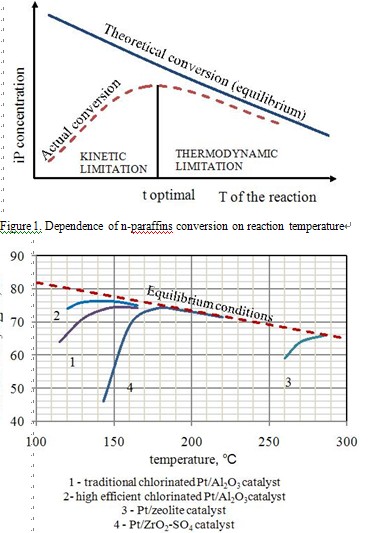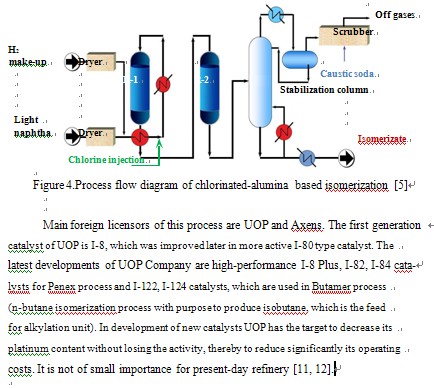Liaoning Haitai Scientific and Technological Development Co.,Ltd
Marketing office:31-floor 1 unit building No.1 Poly Ray New City, Wanghua District Fushun, Liaoning Province, China. Fctory: No.38 Qingtaizi Road, Shenfu New District, Liaoning Province, China
Post Code:113122 E-mail:sales@chinacatalyst.com
辽ICP备2022002379号-1 Powered by 300.cn ShenYang Mobile E-mail
TENDENCY OF ISOMERIZATION PROCESS DEVELOPMENT (2)

The conversion level of n-paraffins on zeolite catalysts is low, as it is limited by thermodynamic equilibrium. In the case of chlorinated-alumina catalysts and sulfated metal oxides conversion of n-paraffins is higher because of high equilibrium content of
isocomponents in product.
4. TECHNOLOGIES OF ISOMERIZATION PROCESS ON DIFFERENT CATALYSTS
Zeolite catalysts are less active and used at higher operating temperature compared to another types of catalysts, and consequently the octane number of isomerizate is low. However they possess high resistance to impurities in the feed and capability for
total regeneration in the reactor of the unit. The technological scheme of this process is provided with fire-heaters for heating hydrogen and feed mixture up to reaction temperature. It is necessary high ratio of hydrogen to hydrocarbon feed (along with isomerization, hydrogen is spent for hydrotreating and dearomatization of the feed); that’s why compressor for supplying of recycle hydrogen-rich gas and separator for separation of hydrogen-rich gas are necessary (Figure 3).

Hysopar catalyst should be marked out among zeolite catalysts; it is the most progressive in the world catalyst market, because it considerably exceeds all another catalysts by resistance to impurities in the feed (available sulfur content is 100 ppm permanently and 200 ppm during short periods of time) [5, 10].
Chlorinated-alumina based catalysts are the most active and supply the highest isomerizate yield and isomerizate octane. It should be noted that during isomerization catalysts loose chlorine, consequently the activity is reduced. That’s why chlorine compound injection to the feed (usually ССl4) is provided for keeping of high activity. As a result, caustic soda washing from organic chloride in special scrubbers is necessary. Considerable drawback is that this type of catalyst is very sensible to poisonous impurities (to the oxygen compounds including water, to nitrogen) and requires pretreatment and drying of the feed. In addition the problems occur at regeneration (Figure
4) [5].







